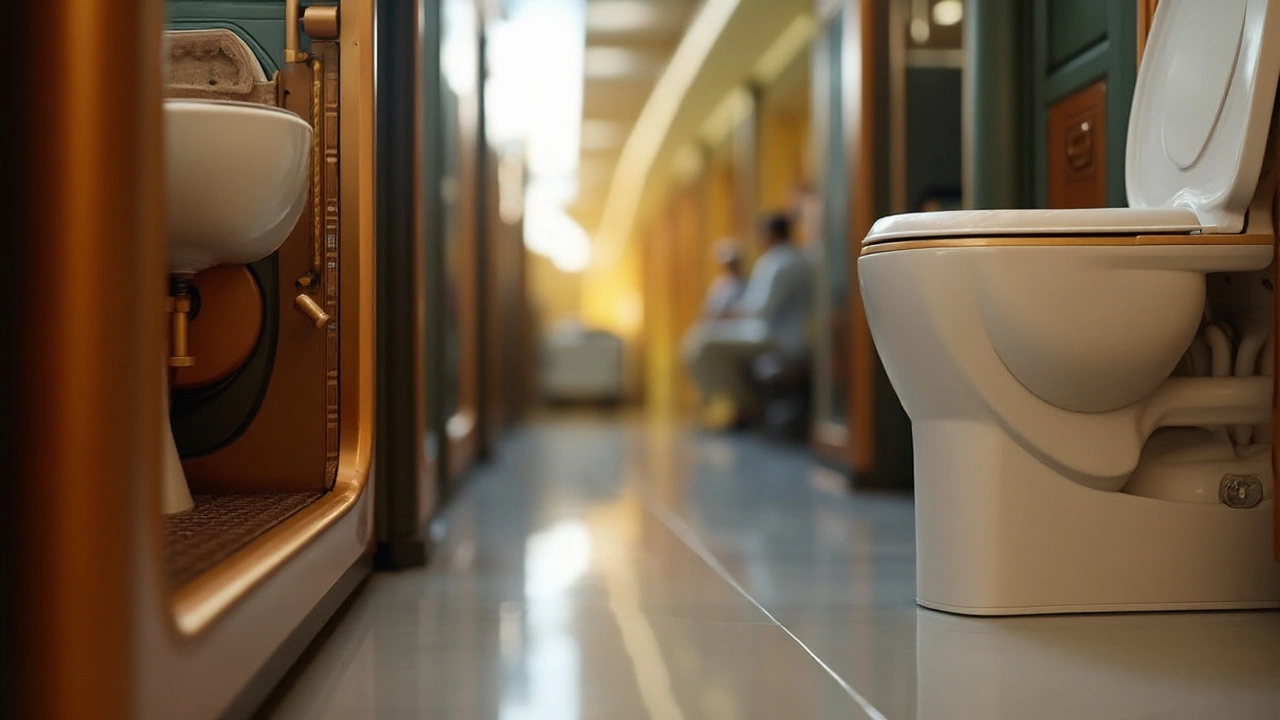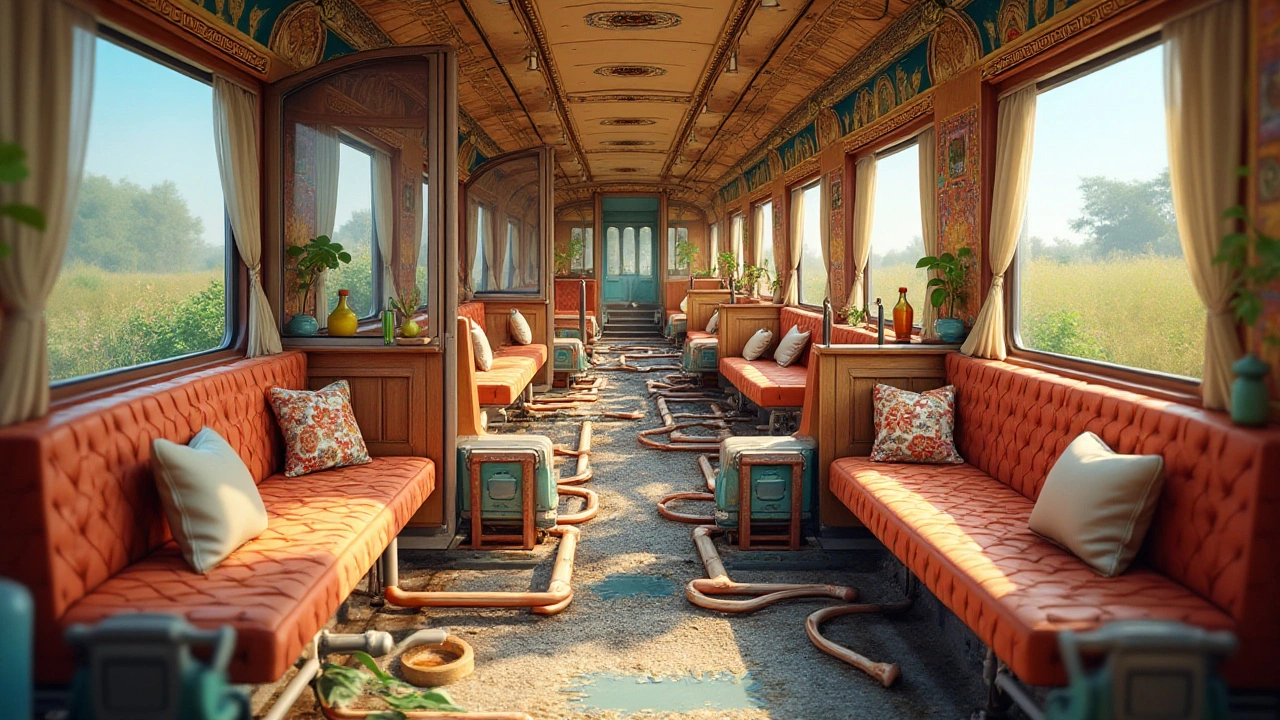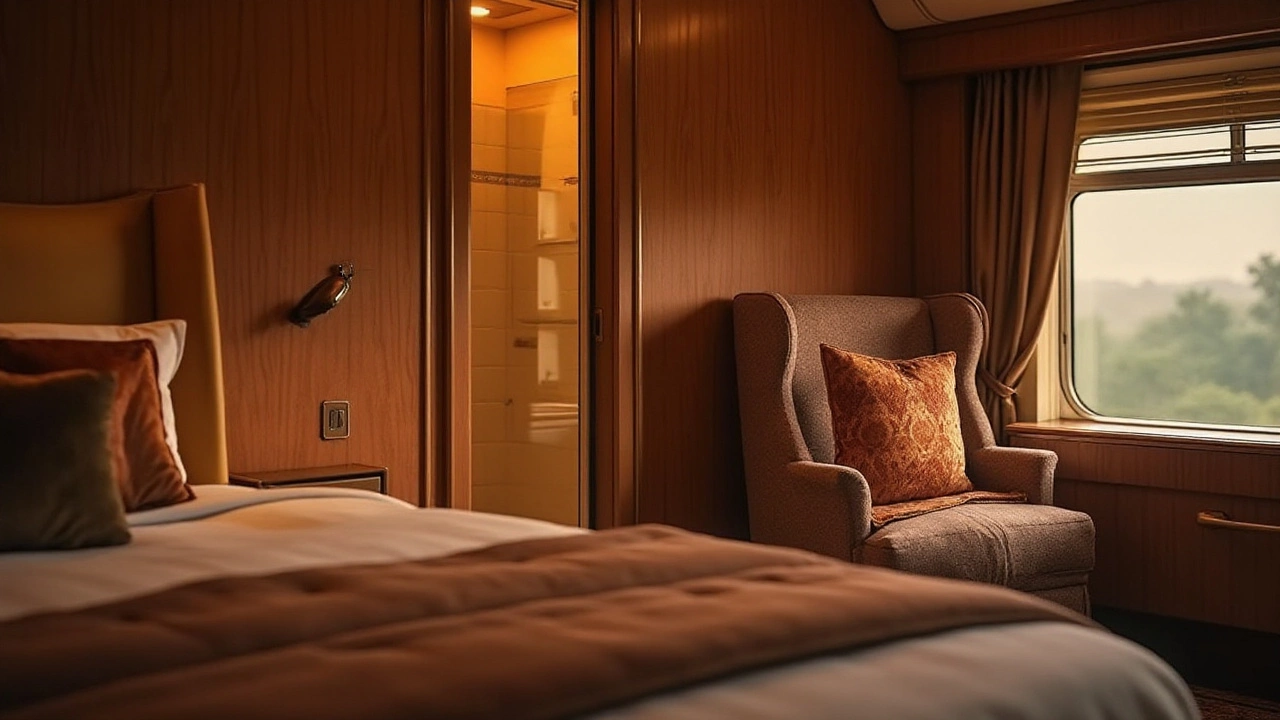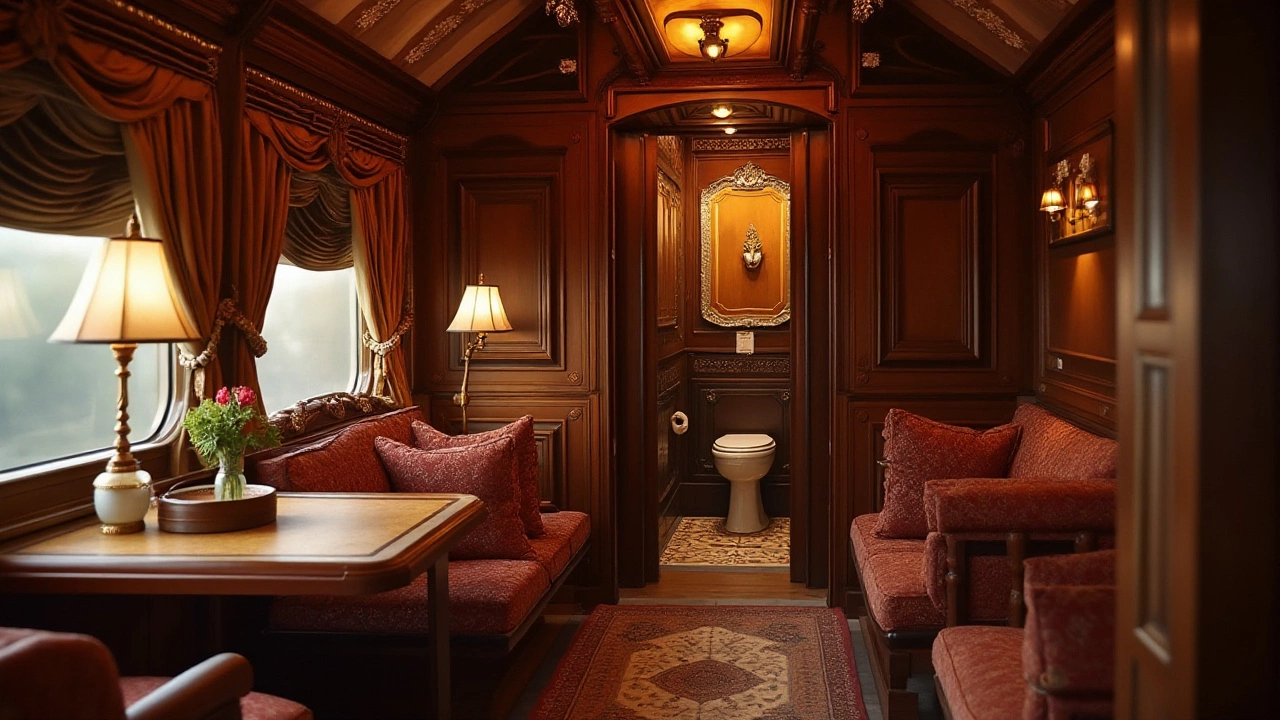When boarding a luxury train, the sumptuous interiors and extravagant amenities captivate travelers, promising a unique adventure across picturesque landscapes. Yet, beneath this veneer of sophistication, there's an often overlooked aspect—train toilets. While perhaps not the most glamorous topic, understanding what happens with train toilets reveals a fascinating blend of engineering and innovation.
Today's train toilets, especially on luxury routes, combine the latest sanitation technology with passenger comfort, ensuring a seamless travel experience. In this journey, we'll uncover the history of train sanitation, explore how modern systems operate efficiently, and discuss the vital role these mechanisms play in maintaining a pleasant environment for travelers. Learn how advancements in toilet technology continue to enhance the luxury train experience while addressing environmental and logistical challenges head-on.
- History and Evolution of Train Toilets
- How Modern Train Toilets Work
- Environmental Considerations and Waste Management
- Guest Comfort and Hygiene Protocols
History and Evolution of Train Toilets
When rail travel first began, the concept of sanitation facilities on trains was rudimentary at best. Early train rides lacked any dedicated toilet facilities, leaving passengers to rely on station stops for relief. It wasn't until the late 19th century that the first genuine on-board toilet appeared, making its debut in the form of a basic drop chute. These initial designs allowed waste to fall directly onto the tracks, which led to practical and environmental concerns that could no longer be ignored as railroads expanded into populated areas.
As rail travel gained popularity, there was growing pressure to improve these primitive solutions. By the early 20th century, advances in plumbing inspired engineers to adopt more sophisticated approaches, leading to the development of flush toilets on trains. This innovation was a game-changer. Not only did it enhance passenger comfort, but it also marked a significant step forward in terms of hygiene and public health. The greatest challenge at that time, however, was finding a way to manage waste effectively without the luxury of a sewer connection, a problem that required increasingly creative engineering solutions.
During the golden age of rail—a time when train travel was at its pinnacle of luxury and style—bathrooms became more elaborate. Art deco fixtures, plush amenities, and smart designs transformed train toilets into a hallmark of first-class travel. In the post-war era, the technology had matured even further, and the invention of the vacuum toilet technology revolutionized how train toilets operated. This system, which uses a powerful vacuum to swiftly and efficiently remove waste, has become a staple on many modern trains today. It minimizes the use of water and ensures that contents are quickly contained, preventing unpleasant odors and promoting cleanliness within the confined coach space.
The narrative of train sanitation has always run parallel with technological advancement and environmental awareness. Innovations have not only focused on technical efficiency but also on reducing the ecological footprint of train travel. Modern systems often incorporate bio-reactors and sophisticated filtration setups to ensure that waste is treated in the most sustainable manner possible, aligning with the broader movement toward greener practices. An interesting tidbit: By 2023, a significant percentage of new train models were being equipped with advanced microbiome toilet systems, which actively break down waste using beneficial bacteria, further minimizing impact on the environment.
"Railway sanitation has always evolved out of necessity, driven by a commitment to both passenger welfare and environmental stewardship. It's fascinating to see the solutions rail engineers have devised over the years," remarked Dr. James Fielding, a transportation historian.
The history of train toilets reflects the broader evolution of train travel itself—from its humble beginnings as a utilitarian mode of transport to its current status as a luxurious journey experience. As our trains get faster, more efficient, and environmentally friendlier, the bathroom systems on-board will continue to evolve with them, perhaps into realms we can hardly imagine today.

How Modern Train Toilets Work
Imagine stepping onto a plush luxury train journey, where every detail is meticulously curated for your comfort. You'll find yourself marveling at the grandeur and elegance of the setting, but the toilet is literally a hidden gem. These sophisticated systems are a marvel of engineering, designed to function seamlessly under all conditions. At the heart of modern train toilets are vacuum technologies that ensure efficiency and hygiene. This not only helps conserve water, but also aids in creating a more pleasant ambiance within the confined quarters of a train. Unlike traditional toilets that rely heavily on water usage, vacuum toilets use a combination of air pressure and a small amount of water to eject waste, making them an eco-friendly feature onboard.
Modern train toilets aren't just about efficiency; they're designed with user comfort in mind as well. Many employ advanced materials that resist odor and bacteria, ensuring a clean-smelling environment. The operation begins with a mechanism that creates suction within the system. This is triggered when a passenger flushes, utilizing the train's air pressure to effectively pull waste into a holding tank. This tank is strategically situated to ensure that the waste is isolated and doesn't interfere with the passenger's experience. The real magic is in how this system performs reliably no matter where the train is or how fast it's moving. To accommodate longer journeys, some systems also incorporate sensors to monitor waste levels, ensuring they're never exceeded. These toilets may even self-clean during stops at main stations, ensuring optimal hygiene for the next user.
"The genius of modern train toilet systems lies in their simplicity and efficiency. Their design not only enhances passenger experience but also minimizes environmental impact," says Dr. Emily Hargrove, a transport systems analyst.
Such efficiency is crucial, given the increasing focus on environmental conservation. With trains operating across diverse geographical landscapes and climates, sanitary systems on trains face unique challenges. Engineers rise to the occasion by implementing energy-efficient systems that comply with stringent environmental regulations. The use of high-tech biodegradables and eco-friendly treatment processes ensures waste doesn't just sit in the holding tanks, but rather decomposes in an environmentally conscious manner. These advancements not only preserve the luxury experience but also protect the natural world. Having such a system working efficiently makes the journey pleasant for every person who steps onboard, offering peace of mind that their experience is both luxurious and sustainable.

Environmental Considerations and Waste Management
One of the most intriguing aspects of modern train toilets is their approach to waste management and the environment. In the past, train sanitation wasn't particularly sophisticated, often emptying waste directly onto the tracks. Nowadays, this primitive method is replaced with environments-conscious practices that preserve the beauty of the landscapes that luxury trains travel through. This evolution speaks volumes about the industry's commitment to eco-friendly advancements.
Modern trains are typically equipped with vacuum toilets similar to those on airplanes, which not only minimize water use but also ensure the waste is compactly managed. This is vital in reducing the environmental impact of luxury train journeys. By using a vacuum system, these toilets require only around half a gallon of water per flush, significantly lower than the several gallons used by conventional toilets. With thousands of travelers, the water saved adds up, reflecting a small yet impactful step towards sustainability.
Attached to these systems are sophisticated waste tanks that store refuse until the train reaches designated disposal facilities. This means that no waste is discharged along the travel route, protecting the local environment. Although these tanks need careful management, the utilization of bioenzymes within the holding tanks helps break down waste biologically, further minimizing the environmental footprint. This approach ensures that trains can serve both as a mode of travel and a model of sustainability.
"We see train toilets as a crucial part of our commitment to sustainable travel," says Marissa Greenfield, Chief Engineer at the renowned Transcontinental Express. "By integrating modern technologies, we're not just providing comfort; we're protecting the world our passengers come to see."
Train toilet management is also an elaborate logistical task, involving precise scheduling and efficient processing to ensure waste is managed responsibly. Innovations like these reflect a subtle blend of engineering ingenuity and ecological awareness. As climate concerns escalate, the industry must continuously adapt, and the train sector's strides in this regard are pivotal. The seamless operation of these systems outlines a commitment not just to luxury, but to preserving the natural beauty they traverse.
This collective effort within the train industry underlines a broader narrative in modern transportation—where advancing technology isn't just about enhancing comfort, but aligning with global sustainability goals. In this way, luxury journeys are more than just opulent experiences; they're testaments to responsible indulgence, where thoughtful development meets the demands of a conscious world. On top of the genuine comfort enjoyed by passengers, these waste management strategies present the dual benefit of ameliorating our environmental impact, cementing eco-friendliness as a non-negotiable pillar of luxury train journeys.

Guest Comfort and Hygiene Protocols
On luxury train journeys, the travelers' comfort transcends beyond plush interiors and gourmet dining. A subtle yet significant factor that enhances the travel experience is the attention to guest comfort and stringent hygiene protocols. The assurance that the onboard facilities, such as train toilets, are maintained at pristine levels of cleanliness is paramount. Travelers often concern themselves with how these spaces are kept fresh, especially on long journeys. Luxury trains excel in this regard, employing meticulous sanitation routines that rival, if not surpass, those found in five-star hotels. Regular cleaning schedules are executed throughout the day, ensuring that each passenger experiences optimal comfort.
Furthermore, the use of state-of-the-art ventilation systems in modern train toilets effectively minimizes odors, a crucial component to a pleasant travel atmosphere. Advanced flush systems, which innovate beyond traditional water-based methods, are specifically designed to operate efficiently while conserving resources, thus contributing to environmental sustainability. This conscientious design not only enhances passenger experience but also underscores the trains' commitment to minimizing their ecological footprint. As a frequent passenger on these opulent rails might affirm, this attention to detail truly elevates the journey, making travel feel as seamless as a luxury hotel stay.
Interestingly, many premium train services have begun integrating digital solutions to proactively address guest needs. Passengers may now have the option to request cleaning services through onboard apps, further personalizing their travel experience. An anecdote often shared in the industry reveals how the iconic Orient Express prioritizes guest feedback and instant communication with the housekeeping staff, illustrating the priority given to sanitation and customer satisfaction. Such examples highlight the innovative convergence of traditional hospitality with modern technology.
"Effective sanitation and passenger comfort are not merely about convenience—they are integral to the luxury train experience," once noted Thomas Bray, a seasoned luxury train conductor, in an industry journal discussing evolving travel amenities.
In addition to technological advancements, luxury trains employ well-trained staff to facilitate these hygiene protocols. Comprehensive training programs ensure that staff members are well-versed in the latest sanitation techniques and customer service skills. This dual focus on cutting-edge technology and committed personnel plays a pivotal role in maintaining the high standards that passengers have come to expect. Such a commitment is evident not only in the infrastructure of the train toilets but also in the staff's dedication to providing impeccable service, making these journeys memorable long after the trip has concluded.
